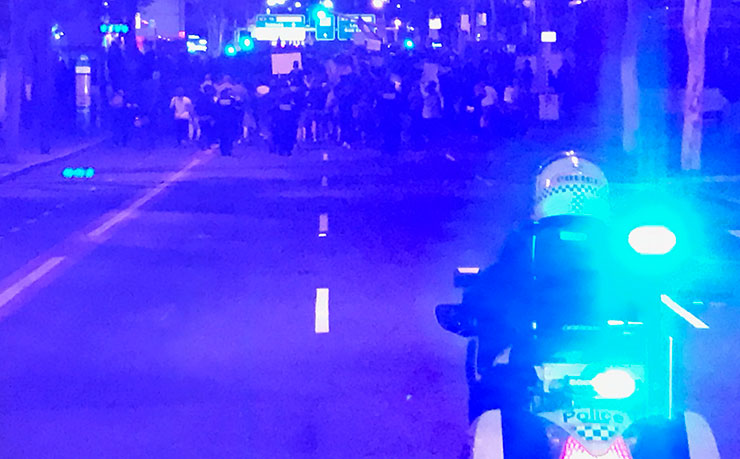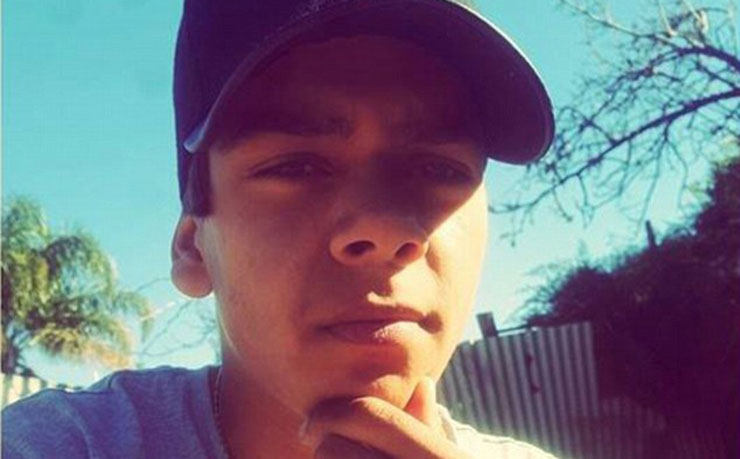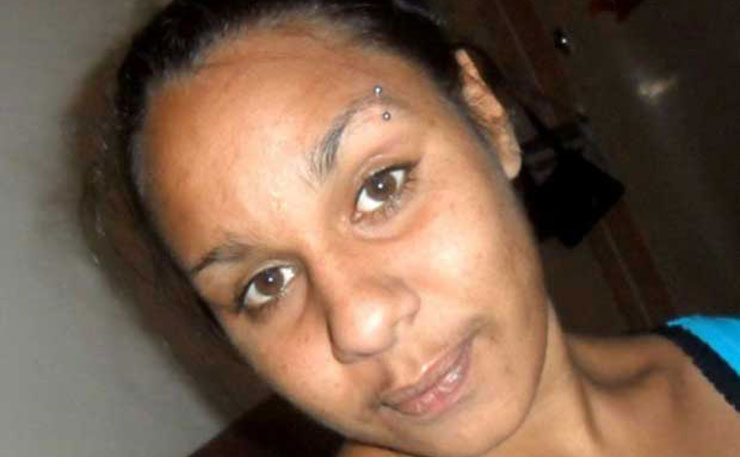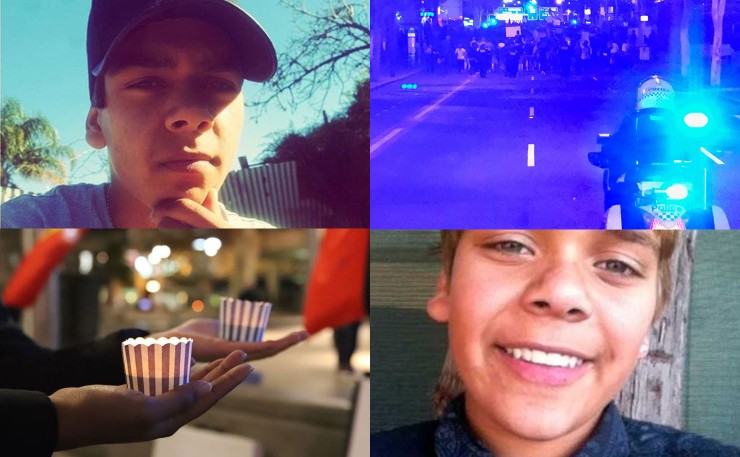In the wake of the sentencing over the death of Elijah Doughty, either our justice system is broken, or non-Aboriginal people only ever kill with pure motives. Dr Lissa Johnson explains.
On Monday this week I attended a rally in Sydney calling for justice for Elijah Doughty, the 14-year-old Aboriginal boy who was chased and killed by a white man driving a ute in Kalgoorlie last year. Three days prior to the rally the man, whose name has been suppressed, had been acquitted by a jury of manslaughter. He pleaded guilty to the lesser charge of dangerous driving occasioning death.
Although the maximum sentence for this conviction is 10 years in prison, the man received only three, with a possibility of parole in February next year.
While the rallies following this verdict have been widely reported as protests against the lenient sentence, the rally that I attended in Sydney was much more than that.
Over the course of around an hour and a half numerous Aboriginal speakers gave powerful speeches about Elijah, about other Aboriginal victims of white crimes, the justice system, the history of racial injustice in Australia, the history of black deaths in Australia, colonialism, racism, activism, holocaust, genocide, and speakers’ own experiences and feelings around these things.
Speaker after speaker placed their deep sense of grief and injustice over Elijah Doughty’s death into this broader political, historical and personal context, with an urgent message for white Australians to “wake up”.
Other rallies were held in major cities and towns across Australia throughout the week and over the weekend.

As most readers will be aware, Elijah Doughty was killed in Kalgoorlie-Boulder in August 2016 by a 56-year-old man who believed Elijah to have stolen his motorbike. Elijah’s death took place against a backdrop of racial antipathy in Kalgoorlie, in which Aboriginal boys riding bikes were key targets.
Facebook hosted discussion groups of over 17,000 members in which “people wrote openly about killing Aboriginal kids”.
In a Facebook thread on a stolen bike a week before Elijah’s death, for instance, one person wrote, “Feel free to run the oxygen thieves over if you see them.” The previous week another wrote, “Everyone talks about hunting down these sub human mutts, but no one ever does.” Still another called for an “annual cull”, adding that Aboriginal people “had better hide”.
According to sentencing remarks in the case, the man who killed Elijah Doughty had had two motorbikes stolen from his property the previous day. After reporting the theft to police, the man took the following day off work and set out to find his bikes. He drove to an area of town recommended by police as a popular dumping ground for stolen bikes, Gribble Creek Reserve.
The Chief Justice in the case noted in sentencing remarks that the man was sleep-deprived and “agitated” as he parked his car near the reserve at 6am and waited. He wrote, “You were understandably agitated by these events and did not get much sleep that night”, noting twice that one of the bikes was of “particular sentimental value” to the man.
Sentencing remarks do not say whether the court explored other possible sources of the man’s ‘agitation’, such as the calls for white vigilantism among some in Kalgoorlie. The Guardian reported that the jury was not informed of this context, as there was no evidence that the man held such views.
The only allusions to race in the court’s sentencing remarks involved references to “the views or actions of an ill-informed lawless group”, also called an “uncontrolled group” and an “unruly group”, meaning the Aboriginal people who had initially protested outside the Kalgoorlie courthouse in 2016 “after you [the defendant]were arrested and charged [with manslaughter instead of murder]”. This ‘lawless group’, according to the Magistrate, was “utterly irrelevant to the sentencing process”.
Of relevance was the fact that the man who killed Elijah waited near Gribble Creek Reserve for almost three hours. Shortly before 9am he saw Elijah ride past on what he recognised as one of his stolen bikes.
There is no evidence that Elijah had stolen the bike or knew that it was stolen. At the time, his own two motorbikes had been confiscated by police, who wrongly believed they were stolen.
Seeing the bike, the man started his ute and gave chase after Elijah, accelerating as he pursued him off-road down a “bumpy” clay and grass track, which became increasingly “deteriorated”, “damp” and “boggy” as he gained speed on Elijah. In a particularly damp area near the creek, the man’s ute ran over Elijah, having accelerated to a speed of approximately 20kph faster than Elijah at the time of impact.

According to a forensic pathologist, the ute hit Elijah so hard that it split his skull and severed his spinal cord instantly. He was dragged under the vehicle, causing 11 broken ribs, multiple fractures to his skull, a fractured spinal column and a fractured leg. The chief justice described the injuries as “horrendous”.
The motorbike was smashed to pieces, thrown 4.5 metres and strewn for 10 metres from the point of impact. Elijah’s body was found 9.5 metres further on.
There was no evidence at the crime scene that the driver had swerved or braked heavily to avoid the collision.
The best of intentions
The man said, in his defence, that he never intended to kill Elijah. His only intention had been to retrieve his bike.
This issue of ‘intent’ has been critical to Elijah Doughty’s case. The man’s charge, conviction and sentence have all revolved around appraisals of his intentions and motivations leading up to Elijah’s death.
Legally, from what I understand, intent to kill makes the difference between manslaughter and murder. Intentionally risking serious harm or death makes the difference between manslaughter and dangerous driving. On the charge of dangerous driving, “reckless indifference to consequences”, among other things, makes the difference between a harsh and a lenient sentence.
The man who killed Elijah Doughty came out clean on all three fronts. Even the “culpability” of his dangerous driving, wrote the Chief Justice, was “in the lower half” of “the range of seriousness” for that offence.
Not being a lawyer, I can’t explain how chasing a child on a small motorbike without a helmet, in a “very large and heavy” two-tonne utility truck, at accelerating speeds over increasingly unpredictable terrain lacks harmful intent. Such an action could reasonably foreseeably cause death or serious harm by head injury alone, even without running the child over.
The defendant himself admitted hoping to cause Elijah to “fall off” the bike as he accelerated “really close” to him.
Not being a lawyer, I also can’t explain how this act lacks “reckless indifference to consequences”. The man even stated that he “didn’t think about” the consequences “at all”. He was only thinking about his bike.
I defy any parent, other than the most reckless or indifferent, to try this on their own child at home, no matter how sleep deprived or agitated they are. No matter how sentimental they may feel about a bike.
Rather than tracing Elijah’s death to the driver’s reckless indifference, however, the court traced it to Elijah’s unpredictable behaviour. Sentencing remarks accepted the man’s account that he only hit Elijah because Elijah swerved right instead of left as he was forced towards the creek’s edge, which, the court wrote, was “unexpected”.
Unexpected?
Is a grown man trying to force a child off a moving motorbike entitled to any expectations of that child? Is speeding “really close” “without thinking about” the child’s safety a sufficiently legitimate activity that we grant the perpetrator a set of rightful expectations?
Like what? Prudent, predictable falling-off behaviour from the child, in the ‘expected’ direction?
The only thing that can be reasonably expected of a child in these circumstances is panic. Why purposefully playing Russian roulette with a child’s life in this way lacks reckless indifference, I can’t say.
A likely story
What I can say, being a psychologist, is that any situation in which one person makes inferences about another person’s intentions and motivations is a highly subjective process. No matter how many times a court asserts its impartiality, human beings do not make these kinds of judgements in impartial ways.
If the science of psychology tells us anything about human cognition, it is that judgement and decision-making are not unbiased exercises in information processing. Cognition is ‘hot’ and ‘motivated’, involving all kinds of subtle, invisible, unconscious forces. Including, but not limited to, racism.
Juries, for instance, arrive at verdicts not by objectively weighing evidence primarily, but by constructing stories. The ‘story model’ of juror decision making is the leading contemporary model, having superseded ‘mental arithmetic’ models in the 1980s.
In making their decisions, jurors weave evidence into narratives that fit fluidly with their pre-existing beliefs, scripts and personal worldviews, including their stereotypes and prejudice.
It is perhaps unsurprising, then, that research in the United States has shown juries to be biased against black defendants and in favour of whites. Black defendants, for example, are more likely to receive the death penalty for comparable crimes, even when controlling for variables such as aggravating and mitigating factors and number of victims killed. This is particularly true if the victims are white. Juries have also been found to be more lenient towards defendants of their own race, unless the evidence against the defendant is overwhelming.
Given these racial biases, it is tragically predictable that a non-Aboriginal jury, such as the jury in Elijah Doughty’s case, instructed on the “irrelevance” of an “unruly”, “lawless” Aboriginal group, would deliver a lenient sentence to a white offender at the expense of justice for an Aboriginal victim.
It is psychologically foreseeable that such a jury would be susceptible to a narrative in which the white perpetrator meant no harm. In which killing a black person was a regrettable accident, devoid of malice, intent or hate. An unfortunate mistake.
This, it seems, is the story that proved most plausible to the jurors in the Elijah Doughty case. The unspoken subtext, that a white man’s property, not an Aboriginal life, was sacrosanct, is probably so familiar as to be unconscious.
To Aboriginal people, however, the innocent-white-killer story is less convincing.
Aboriginal people remember Mulrunji Doomadgee, beaten so savagely to death that his liver was cleaved in two. They remember countless other Aboriginal people, too numerous to name here, beaten, cooked, kicked, shot and run over, all dead, none of whose killers were charged with murder. Most of whose killers were acquitted of even manslaughter.
Aboriginal people from Kalgoorlie know that Kalgoorlie kids are “always getting chased” by white people in cars, and that it is “reported [but]nothing done about it.”
The story in which a white man murders an Aboriginal boy and gets away with it is the more familiar one to Aboriginal people.
After the announcement of the manslaughter charge in Elijah Doughty’s case last year, New Matilda editor Chris Graham wrote White Man’s Manslaughter. Black Man’s Murder, detailing the long history of injustices behind Kalgoorlie protesters’ anger. He said, “There isn’t an Aboriginal family in this country untouched by state-sanctioned violence”.
And here the state is again, sanctioning the violence against Elijah Doughty as being in the “lower half” of “the range of seriousness” of a dangerous driving offence.
None of us, of course, can see inside the heart and mind of the man who killed Elijah Doughty at the time he ran him down. No-one ever can. But if our justice system is to be believed, white killers of Aboriginal people in Australia never act with malicious intent. They always kill Aboriginal people accidentally. We white Australians kill Black Australians with the best of intentions. Over and over again.
Sadly for racial justice in Australia, our penalties for white crimes against black victims have not been scrutinised empirically, as far as I know. Most research on racial justice has focussed on Aboriginal defendants, not white perpetrators of crimes against Aboriginal victims. I am unaware of any peer-reviewed studies on the subject.
In an ongoing effort to fill the gap, however, Chris Graham wrote a second article on the subject, The Killing Fields, documenting just some of the “litany of justice system failures” that preceded the Elijah Doughty verdict. He describes a “lengthy catalogue of deaths spanning decades – and longer…[involving]victims and their families failed spectacularly by Australia’s justice system”. “Case after case after case”, he said on Late Night Live, involves unpunished white crimes against Aboriginal people.

The day before the acquittal of Elijah Doughty’s killer, the family of Ms Dhu, a Yamatji woman who died in custody in 2014, announced that they would sue the state of Western Australia over her death. A coronial inquest last year recommended no charges or demotions for police officers involved in the “inhumane” treatment that cost Ms Dhu her life. Chris Graham pointed out on Late Night Live that “no-one in modern Australian history has ever been jailed for the death in custody of an Aboriginal person”.
Wiradjuri and Torres Strait Islander woman Lynda-June Coe, organizer of the rallies across Australia, asked, in anguish, “When does this insanity stop?”
The impact of unpunished hate crimes
Will the Elijah Doughty judgement mark a turning point for racial injustice in Australia? Was Wiradjuri man Joe Williams right when he said at the Sydney rally, “We’re having non Indigenous brothers and sisters now standing with us. Because you see the injustice.”
Are we white Australians finally waking up? Or will we move on with the next news cycle, as we have done so many times before, and forget? Will the enduring legacy of this judgement be to feed the broader cycle of injustice and disadvantage, as such judgements always have?
Williams said, “We’ve seen drug and alcohol problems in our communities. We’ve seen the highest suicide rates on the planet. But people might say to me, ‘What has that got to do with [the Elijah Doughty verdict]?’ I’ll tell you what it has to do with it… That verdict was handed down, that family goes into a deep depression. That family may turn to alcohol to help to get through tough times, like many other people do…. This injustice is why we get upset, why we react, why we turn to alcohol, why in some cases we are incarcerated, why we have the highest suicide rate in the world.”
In addition to compounding Aboriginal trauma and disadvantage, lenient sentences for white crimes against black victims also fuel the very racism that drives racial injustice in the first place.
In a sadly prescient study, just months prior to Elijah’s death last year researchers from Queensland, Deakin and Cornell Universities published a paper entitled The Impact of Unpunished Hate Crimes. The research team compared readers’ responses to two fictitious newspaper accounts of a racially motivated killing, in which a white male teenager ran over and killed an Aboriginal teenager, following an argument.
In one version, the white perpetrator was convicted of murder and sentenced to life in prison. In the other he was convicted of dangerous driving causing death, given a light jail sentence, and the hate crime charge was dismissed.
When the white perpetrator got off lightly, rather than reacting against the lenient sentence, readers “derogated the individual Aboriginal Australian victim” and “expressed greater racism toward the victim’s group”. They did this “in order to restore their perceptions of the situation’s fairness”. Readers with ‘just world beliefs’, in other words those who viewed the world as fair and just, were most susceptible to these effects.
The authors noted that their findings support “the alarming hypothesis that racist hate crimes are not only the manifestation of a racist society, but may also bolster racial prejudices if leniently treated”. They stressed that their findings “highlight the important role of political and judicial authorities, whose response or non-response to a hate crime can exacerbate or ameliorate existing prejudices”.
Given the serial non-responsiveness of our political and judicial authorities, an important implication, say the authors, is that, “how society responds to a hate crime can [also]exacerbate or ameliorate prejudice, such that ignoring or dismissing discrimination can strengthen existing biases”.
This fact was not lost on the speakers at the Sydney rally. Meyne Wyatt, relative of Elijah Doughty said, “I’m so happy to see my non-Indigenous brothers and sisters here, along with my Indigenous brothers and sisters. We need you here. We need you to be angry. We need you to feel our rage.”
Joe Williams said, “You know what? We’re not going to do it by ourselves… start to wake up. You are our allies. You walk with us every day and night. You are our brothers and sisters. We cannot do it alone. We make up only three per cent of this country. We need you. We need you to see the injustice that has been happening for generations.”
* New Matilda survives on reader subscriptions, and most of our writers such as Lissa Johnson are unpaid. If you want quality, independent investigations and analysis on a shoe-string budget, please considering subscribing for as little as $6 per month. Click here.
Donate To New Matilda
New Matilda is a small, independent media outlet. We survive through reader contributions, and never losing a lawsuit. If you got something from this article, giving something back helps us to continue speaking truth to power. Every little bit counts.





